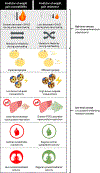Metabolic Factors Determining the Susceptibility to Weight Gain: Current Evidence
- PMID: 32248352
- PMCID: PMC7263968
- DOI: 10.1007/s13679-020-00371-4
Metabolic Factors Determining the Susceptibility to Weight Gain: Current Evidence
Abstract
Purpose of review: There is substantial inter-individual variability in body weight change, which is not fully accounted by differences in daily energy intake and physical activity levels. The metabolic responses to short-term perturbations in energy intake can explain part of this variability by quantifying the degree of metabolic "thriftiness" that confers more susceptibility to weight gain and more resistance to weight loss. It is unclear which metabolic factors and pathways determine this human "thrifty" phenotype. This review will investigate and summarize emerging research in the field of energy metabolism and highlight important metabolic mechanisms implicated in body weight regulation in humans.
Recent findings: Dysfunctional adipose tissue lipolysis, reduced brown adipose tissue activity, blunted fibroblast growth factor 21 secretion in response to low-protein hypercaloric diets, and impaired sympathetic nervous system activity might constitute important metabolic factors characterizing "thriftiness" and favoring weight gain in humans. The individual propensity to weight gain in the current obesogenic environment could be ascertained by measuring specific metabolic factors which might open up new pathways to prevent and treat human obesity.
Keywords: Brown adipose tissue; FGF21; Lipolysis; Sympathetic nervous system; Thrifty phenotype; White adipose tissue.
Conflict of interest statement
Figures

References
-
- Norgan NG, Durnin JV: The effect of 6 weeks of overfeeding on the body weight, body composition, and energy metabolism of young men. Am J Clin Nutr 1980;33:978–988 - PubMed
Publication types
MeSH terms
Substances
Grants and funding
LinkOut - more resources
Full Text Sources
Medical
Research Materials

